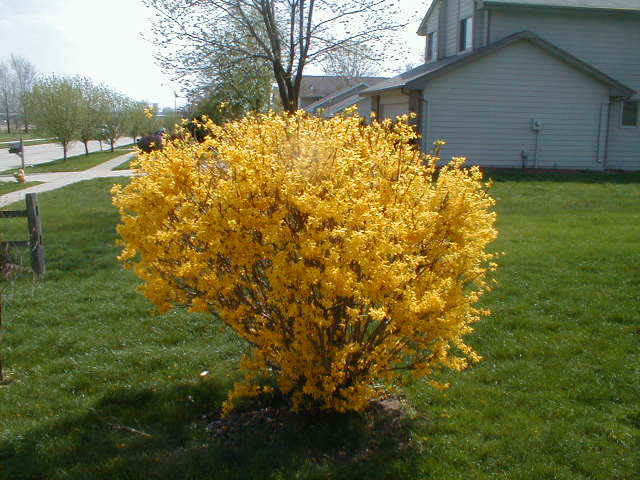Forsythia and Flowering Quince Bushes – Plants That “Shout” Spring!!
Plant Taxonomy of Forsythia Bushes:
The plant taxonomy of border forsythias is Forsythia x intermedia. They are a hybrid of greenstem (F. viridissima) and a weeping type (F. suspensa). This plant profile deals with F. x intermedia. These plants are sometimes given the common name, “golden bells.” Note: forsythia is often misspelled as either “forcynthia,” but, I assure you, they’re not just for Cynthia, they’re for you, for me, and for anyone else who loves beautiful flowers in spring.
Plant Type:
Border forsythias are deciduous shrubs.
USDA Plant Hardiness Zones for Forsythia Bushes:
Border forsythia plants are hardy to zone 7.

Characteristics of Forsythia Bushes:
These early bloomers sport the vibrant yellow flowers that have become a fixture of our spring dreams. Their flowers precede their leaves. Border forsythias are fast-growing shrubs with an upright and arching form. “Sunrise” forsythia (Forsythia x intermedia‘Sunrise’) is more compact than many forsythia shrubs, growing 4′-6′ tall with a spread of 3′-5′. By contrast, Forsythia x intermedia ‘Meadowlark’ grows 8′-10′ tall. In between is Forsythia x intermedia ‘Northern Gold’, at 6′-8′ tall.
Plant Care for Forsythia Shrubs:
See below under “When to Prune Forsythia Bushes.” If left to their own devices, forsythia plants take on a rather wild-looking shape, as branches shoot out this way and that. Most people prefer this wild look, pruning forsythia bushes only sparingly. Through regular pruning, you can shape forsythia bushes to conform to a more regular shape, if you so choose.
Sun and Soil Requirements for Forsythia Plants:
Forsythia plants grow best in full sun and well-drained soil.
Forsythia Shrubs in Landscape Design – Uses:
Border forsythias, as the name suggests, is often used to demarcate property boundaries. They are also often used as a “living wall” privacy fence for summer and fall after they have fully leafed out. Forsythia plants can also be used as specimens for erosion control on slopes.
You can also force forsythia. It’s a great way for the impatient to gain an early taste of springtime.
When to Prune Forsythia Bushes:
Pruning of forsythia bushes is best done just after they’ve finished putting on their flower display in spring because they bloom on the prior year’s growth (pruning either too late or too early interrupts the growth/blooming cycle). Begin by pruning 1/4 to 1/3 of the oldest branches, pruning them right down to the ground. This will encourage new growth and a more compact form. Beyond this “renewal pruning,” you can also selectively cut newer branches in order to improve upon the overall shape of your forsythia plants.Note that annual pruning is by no means mandatory. If you’re happy with your forsythia shrubs as they are, you may wish to go several years between prunings. Note also that there’s an additional incentive for pruning forsythia shrubs just after their spring blooms start to fade, beyond wishing not to interrupt the growth/blooming cycle. This is the time when it’s easiest to tell the newest branches apart from the older. Only the older branches will have blooms; the first-year branches won’t have any yet, so you have a graphic reminder to avoid pruning them.
Plant Taxonomy of Flowering Quince:
The taxonomy of the type of flowering quinces. Most popular cultivarsin the Double Take™ series: ‘Scarlet Storm,’ ‘Orange Storm’ and ‘Pink Storm.’
Plant Type:
Flowering quinces are multi-stemmed deciduous shrubs.
Characteristics:
Bushes in the Double Take™ series reach a maximum of about 4 feet tall by 4 feet wide, meaning they’re more compact than some older varieties of flowering quince shrubs. As their cultivar names indicate, they bear red flowers, pink flowers, or orange flowers. The bushes in this series are thornless and fruitless. Plants bloom in February in our climate zone zone.
The series name is indicative not only of the notion that you’ll “do a double take” when you witness the beauty of these bushes’ blooms but also of the fact that they have double-flowers.
Planting Zones for Flowering Quince Shrubs:
Sun and Soil Requirements:
Grow flowering quince shrubs in full sun (for the best flowering display) and in well-drained soil. To fertilize, use a slow-release fertilizer in early spring, or apply compost as a soil amendment. According to the Missouri Botanical Garden, an overly alkaline soil pH can lead to problems with chlorosis, so keep it slightly acidic or neutral.
Uses:
Not showy enough from season to season to be used as a specimen plant, I recommend growing it en masse along borders or as an early-spring accent in mixed border plantings. I have also seen varieties that bear thorns planted in hedges, for which the thorns furnish a measure of security. The old-time favorite Chaenomeles japonicais a classic cottage garden plant; the fruit was used in jellies, in a pinch.
Wildlife Attracted by Flowering Quince Shrubs:
In terms of drawing “good” wildlife, they are known to be plants that attract hummingbirds.
Care:
Prune just after blooming is over since the bush blooms on old wood.
Mulch to suppress weeds and retain soil moisture. While these are reasonably drought-tolerant plants once established, young plants will usually need to be watered at times.
Outstanding Features:
What is the best feature of these plants? That’s a no-brainer: the gorgeous red, pink and orange colors of the flowers. Other types of flowering quince shrubs can produce white flowers (there’s a cultivar called ‘Jet Trail’), although I rarely see this color in people’s yards. I think most people share my view that the value of these plants lies almost exclusively in the exquisite color of the pink, red and orange varieties. Until next time…Happy Gardening!!
Jimmie